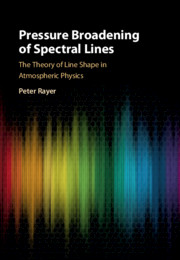Book contents
- Frontmatter
- Dedication
- Contents
- Preface
- Part One Preparing the Way
- Part Two Broadening Theory
- 4 Isolated Lines
- 5 Overlapping Lines
- 6 Liouville Formalism
- Part Three Atmospheric Spectra
- Part Four The Background
- Appendix 1 State Space
- Appendix 2 Product Space
- Appendix 3 Projectors
- Appendix 4 Vector Operators
- Appendix 5 Quantum Dynamics
- Appendix 6 Scattering Theory
- Appendix 7 Resolvent Methods
- Appendix 8 Linear Response
- Appendix 9 Correlation Function
- Appendix 10 Complex Time
- Appendix 11 Absorption
- Appendix 12 Multipole Moments
- Appendix 13 Angular Momentum
- Appendix 14 The Wigner–Eckart Theorem
- Appendix 15 Reduced Amplitudes
- Appendix 16 Units and Other Matters
- Appendix 17 Plasma Spectra: Pointers
- Notes
- References
- Index
5 - Overlapping Lines
from Part Two - Broadening Theory
Published online by Cambridge University Press: 26 June 2020
- Frontmatter
- Dedication
- Contents
- Preface
- Part One Preparing the Way
- Part Two Broadening Theory
- 4 Isolated Lines
- 5 Overlapping Lines
- 6 Liouville Formalism
- Part Three Atmospheric Spectra
- Part Four The Background
- Appendix 1 State Space
- Appendix 2 Product Space
- Appendix 3 Projectors
- Appendix 4 Vector Operators
- Appendix 5 Quantum Dynamics
- Appendix 6 Scattering Theory
- Appendix 7 Resolvent Methods
- Appendix 8 Linear Response
- Appendix 9 Correlation Function
- Appendix 10 Complex Time
- Appendix 11 Absorption
- Appendix 12 Multipole Moments
- Appendix 13 Angular Momentum
- Appendix 14 The Wigner–Eckart Theorem
- Appendix 15 Reduced Amplitudes
- Appendix 16 Units and Other Matters
- Appendix 17 Plasma Spectra: Pointers
- Notes
- References
- Index
Summary
The theory of Baranger is discussed, relating it to the approach taken by Anderson in the last chapter and that taken by Fano in the one to follow. Baranger is concerned to describe pressure broadening in a band of close, overlapping lines. His original concern was with line broadening by fast-moving electrons in a plasma, which allowed him to use the impact approximation, but not to assume that collisions may be associated with classical paths. For this reason, although matter here is in the form of neutral molecules, the use of Baranger’s theory in its most general form requires that collisions be treated in terms of quantum scattering theory. In forming the correlation function, Baranger sets the algebra in a product space where line vectors take the place of the energy states used by Anderson, and the optical cross-section that governs line broadening is replaced by the matrix of an operator in line space, with line widths and shifts on the diagonal and line coupling parameters for the other elements. In the case of isolated lines, Anderson’s theory may be regained, but the introduction of line space paved the way, later on, for a much more general viewpoint.
Keywords
- Type
- Chapter
- Information
- Pressure Broadening of Spectral LinesThe Theory of Line Shape in Atmospheric Physics, pp. 129 - 187Publisher: Cambridge University PressPrint publication year: 2020



